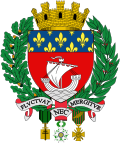



| History of Paris |
|---|
 |
| See also |
|
|
Paris in the 17th century was the largest city in Europe, with a population of half a million, matched in size only by London. It was ruled in turn by three monarchs; Henry IV, Louis XIII, and Louis XIV, and saw the building of some of the city's most famous parks and monuments, including the Pont Neuf, the Palais Royal, the newly joined Louvre and Tuileries Palace, the Place des Vosges, and the Luxembourg Garden. It was also a flourishing center of French science and the arts; it saw the founding of the Paris Observatory, the French Academy of Sciences and the first botanical garden in Paris, which also became the first park in Paris open to the public. The first permanent theater opened, the Comédie-Française was founded, and the first French opera and French ballets had their premieres. Paris became the home of the new Royal Academy of Painting and Sculpture, and of some of France's most famous writers, including Pierre Corneille, Jean Racine, La Fontaine and Moliere. Urban innovations for the city included the first street lighting, the first public transport, the first building code, and the first new aqueduct since Roman times.
